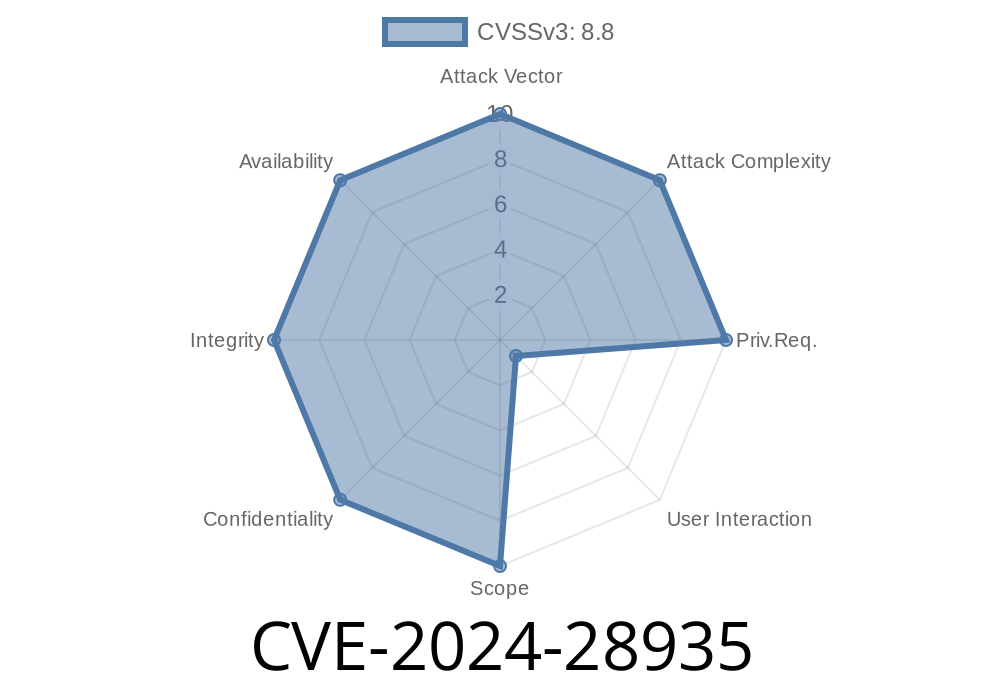A new vulnerability (CVE-2024-28935) has recently been discovered in Microsoft's ODBC Driver for SQL Server, which could allow an attacker to remotely execute arbitrary code on the affected system. In this post, we will dive into the technical details of this vulnerability, analyze the code snippets responsible for the weakness, provide links to original references, and discuss potential exploit scenarios. With the increasing number of organizations relying on Microsoft SQL Server for their critical database operations, understanding and addressing this vulnerability is of utmost importance.
Overview
The vulnerability lies in the MS ODBC Driver for SQL Server - a critical component for applications to connect to SQL Server databases and execute queries. An attacker who successfully exploits this vulnerability can execute arbitrary code on the affected system with the privileges of the SQL Server process. This could potentially lead to unauthorized access to sensitive data, data corruption, or denial of service conditions.
SQL Server 2019
More information about affected versions can be found in the Microsoft Security Advisory.
Code Snippet Analysis
The vulnerability stems from inadequate input validation in the ODBC driver's handling of certain SQL queries. A specially crafted SQL query containing malicious input could trigger a buffer overflow in the ODBC driver, allowing an attacker to execute arbitrary code with the privileges of the SQL Server process.
Here is a simplified version of the vulnerable code snippet
void processData(char *query) {
char buffer[512];
strcpy(buffer, query); // Vulnerable function
// ... process the query
}
When the strcpy function is called, it copies the contents of the query argument to the buffer without checking the size of the input. This can cause a buffer overflow if the attacker sends a specially crafted SQL query that's larger than the allocated buffer size (512 bytes in this example).
Exploit Details
To exploit this vulnerability, an attacker would first need to identify a susceptible SQL Server and get access to its ODBC Driver through an application or service that uses the driver. The attacker could then send a specially crafted SQL query through the ODBC Driver which would cause a buffer overflow and eventually execute arbitrary code.
For example, an attacker might exploit the vulnerability like this
1. Identify an application that uses the vulnerable ODBC Driver and has access to the target SQL Server.
2. Craft a malicious SQL query that triggers the buffer overflow. Here's an example of a potentially malicious query:
`
In this query, the REPLICATE function is used to create a string of 600 'A' characters, which would cause a buffer overflow in the vulnerable code snippet mentioned earlier.
3. Send the malicious query to the application, which passes it to the ODBC Driver and triggers the buffer overflow and remote code execution.
Mitigations
Microsoft has released patches for the affected versions of ODBC Driver for SQL Server, which address this vulnerability by properly validating input and preventing buffer overflow conditions. You can find the corresponding patches in the Microsoft Security Advisory. Organizations using the affected versions of the ODBC Driver should apply the patches as soon as possible to mitigate the risks associated with this vulnerability.
Additionally, security best practices such as input validation, secure coding techniques, and limiting access to SQL Servers can reduce the likelihood of a successful attack.
Conclusion
CVE-2024-28935 is a severe vulnerability that could lead to remote code execution on systems running the affected versions of Microsoft's ODBC Driver for SQL Server. Organizations must take immediate action to patch their systems and employ security best practices to prevent attackers from exploiting this weakness. Make sure to share this information with your team so that you can keep your organization's data safe and secure.
Timeline
Published on: 04/09/2024 17:15:54 UTC
Last modified on: 04/10/2024 13:24:00 UTC
